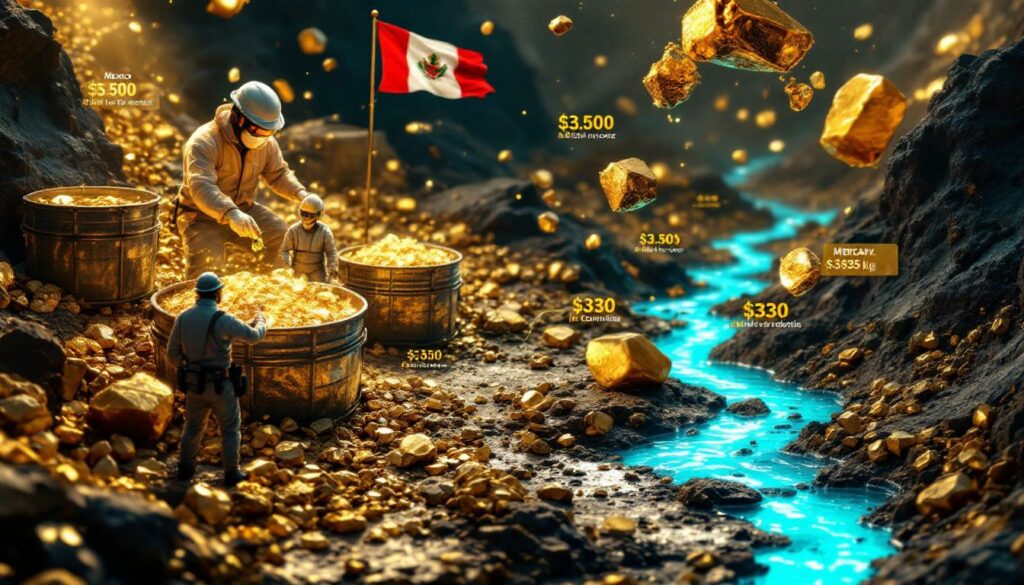Mercury Trafficking in Illegal Gold Mining: Peru's Record Seizure
Peru's recent interception of 4 metric tons of mercury represents the largest seizure of black market mercury in South America's Amazon region. This landmark discovery highlights the growing illegal trade network supplying mercury to unlicensed gold mining operations across Bolivia, Colombia, and Peru. The seized mercury, cleverly disguised as crushed rock, originated from Mexico and was detected at Peru's Callao port by customs authorities (SUNAT).
"We could determine that mercury was being transported in its natural state, camouflaged in shipments of gravel," stated SUNAT officials following the seizure operation.
This record-breaking interception, valued at approximately $1.32 million, represents a significant blow to trafficking networks that have smuggled an estimated 200 tons of mercury from Mexico since 2019. Previous seizures pale in comparison, with the largest prior confiscation being approximately 2 tons in Colombia in 2015.
Key details of the seizure operation
- Mercury was professionally camouflaged as gravel shipments, requiring specialized detection methods
- Located through advanced material analysis by Peru's customs agency (SUNAT)
- Shipment originated from Mexico and was bound for Bolivia, following established trafficking routes
- Environmental Investigation Agency (EIA) provided crucial intelligence leading to the interception
How Does Mercury Fuel Illegal Gold Mining?
Mercury plays a critical role in artisanal and small-scale gold mining operations, particularly in the Amazon basin. Miners use this toxic metal to extract gold from riverbank sediments through a process called amalgamation, which allows them to separate gold particles from other materials.
"Miners use mercury to leach gold from sediment of the Amazon riverbanks," reported the Environmental Investigation Agency (EIA) in their investigation of the illegal mercury trade. This simple yet environmentally devastating process enables mining operations in remote and often protected areas that would otherwise be inaccessible to industrial-scale operations.
The amalgamation process requires minimal equipment and technical knowledge, making it ideal for unauthorized mining operations. However, this accessibility comes at a severe environmental and human cost.
Mercury's role in gold extraction
- Used to leach gold from Amazon riverbank sediments by forming amalgams
- Mercury binds with gold particles, separating them from surrounding materials
- Process allows extraction without sophisticated equipment or infrastructure
- Enables mining in remote, often protected areas where industrial equipment cannot reach
Environmental and health impacts
- Mercury releases toxic vapors during the heating process when the amalgam is burned
- Contaminates local water systems through direct dumping and runoff
- Creates long-term health hazards for communities, with effects lasting generations
- Causes neurological damage, developmental issues, and other severe health conditions
Warning: Mercury exposure can cause irreversible neurological damage, especially in children and developing fetuses. One gram of mercury can contaminate an eight-acre lake to the point where fish are unsafe to eat.
What's Driving the Black Market Mercury Trade?
The illegal mercury trade has seen explosive growth, driven by several interconnected factors creating a profitable underground economy spanning multiple countries. According to data from the EIA and customs authorities, this illicit market is expanding in direct response to global record gold prices analysis.
"According to traffickers, gold miners' demand for mercury has driven the sophisticated operation and made it profitable," the EIA reported in their investigation of trafficking networks.
Economic drivers
- Record mercury prices reaching unprecedented $330 per kilogram
- Soaring gold prices, up 28.5% in 2025 alone
- Gold reaching a historic high of $3,500 per troy ounce in April 2025
- Conservative estimate of $8 billion in illegal gold production linked directly to smuggled mercury
The economic incentives have intensified with Mexico emerging as a major source of illegal mercury since early 2025. This shift in supply chains appears directly correlated with increased international restrictions under the Minamata Convention, which Mexico has been slower to implement fully.
Supply chain connections
- Mexico emerging as the primary source of illegal mercury in the Americas
- Sophisticated trafficking networks connecting Mexican suppliers to South American miners
- Approximately 200 tons of mercury smuggled between April 2019 and June 2025
- Increased illegal mercury production in Mexico since early 2025 coinciding with price spikes
How Extensive is the Illegal Mercury Trade Network?
Research by the Environmental Investigation Agency (EIA) reveals a complex and growing network of mercury trafficking that connects Mexican suppliers with illegal gold mining operations across multiple South American countries. The recent 4-ton seizure represents just a fraction of the total volume moving through these sophisticated networks.
The scale of this operation suggests significant criminal organization involvement, with sophisticated concealment methods and established routes through major ports and border crossings.
Scale of operations
- 200 tons of mercury smuggled from Mexico since 2019
- Previous largest seizure was only half the size (approximately 2 tons in Colombia)
- Conservative estimate of $8 billion in illegal gold production linked to this mercury
- Increasingly sophisticated concealment methods to evade detection, including chemical disguising
International connections
- Primary destination countries: Bolivia, Colombia, and Peru
- Mexico serving as the main source country since early 2025
- Trafficking routes through major ports and established border crossings
- Clear involvement of organized criminal networks with sophisticated logistics capabilities
What Are the Broader Implications for Gold Mining?
The seizure comes amid a global gold price surge that has intensified illegal mining activities worldwide, creating environmental devastation and social conflicts in gold-rich regions. With gold market trends reaching $3,370 per ounce by July 2025, economic incentives for illegal mining have never been stronger.
The boom in illegal mining operations has brought with it increased violence and exploitation in mining regions. Reports indicate deadly conflicts from West Africa to Peru directly related to control of illegal mining operations and their supply chains.
Global gold market factors
- 28.5% increase in gold prices in 2025 alone
- Record high of $3,500 per troy ounce in April 2025
- Economic uncertainty driving unprecedented investor interest in gold as a safe-haven asset
- Increased mining activity in response to higher prices, particularly in unregulated operations
Social and security impacts
- Deadly conflicts in mining regions from West Africa to Peru
- Recent violent incidents in Peruvian mining areas related to territorial control
- Increased criminal organization involvement in mining operations and supply chains
- Exploitation of vulnerable communities, including forced labor and dangerous working conditions
The table below illustrates the dramatic rise in gold prices that has fueled this illegal mining boom:
| Year | Average Price (USD/oz) | Year-End Price (USD/oz) | Annual Change (%) |
|---|---|---|---|
| 2020 | $1,770 | $1,898 | +24.6% |
| 2021 | $1,800 | $1,829 | -3.6% |
| 2022 | $1,802 | $1,824 | -0.3% |
| 2023 | $1,940 | $2,063 | +13.1% |
| 2024 | $2,350 | $2,720 | +31.8% |
| 2025 (YTD) | $3,100 | $3,370* | +28.5%* |
*As of July 2025
How Are Authorities Responding to Mercury Trafficking?
The successful interception of this large mercury shipment represents a significant achievement in the fight against illegal mining, though challenges remain in addressing the root causes of the problem. This operation demonstrates the value of international cooperation and intelligence sharing in combating trafficking networks.
The EIA played a crucial role in alerting Peruvian authorities to the shipment, highlighting the importance of non-governmental organizations in supporting enforcement efforts. SUNAT's sophisticated analysis capabilities were key to detecting the disguised mercury.
Enforcement actions
- Successful collaboration between international organizations (EIA) and Peruvian authorities
- EIA research and intelligence directly supporting the enforcement operation
- Increased scrutiny at ports and border crossings throughout the region
- Advanced analysis capabilities to detect cleverly disguised shipments
Regulatory challenges
- Strict environmental controls on mercury under the Minamata Convention being circumvented
- Difficulties monitoring remote mining operations across vast Amazon regions
- Limited resources for enforcement in complex terrain and isolated areas
- Need for enhanced international cooperation to address cross-border trafficking networks
What Solutions Could Address Illegal Mercury Use in Mining?
Tackling the illegal mercury trade requires a multi-faceted approach that addresses both supply and demand while providing alternatives for communities dependent on mining income. Effective solutions must balance enforcement with economic realities.
Potential interventions
- Strengthened border controls and inspection capabilities with advanced detection technology
- Expanded international agreements on mercury trade restrictions and enforcement
- Development of alternative livelihoods for artisanal miners in affected regions
- Investment in mine reclamation innovation and sustainable practices
Policy considerations
- Balancing strict enforcement with economic realities in mining-dependent communities
- Addressing corruption in regulatory systems that enable trafficking
- Formalizing artisanal mining operations where appropriate to bring them under regulatory oversight
- Creating market incentives for legal, mercury-free gold production
Expert insight: "The solution to mercury trafficking must address both supply chains and market incentives. Enforcement alone cannot succeed without providing viable alternatives for mining communities." – Environmental Investigation Agency
FAQ: Mercury in Illegal Gold Mining
Why is mercury used in gold mining?
Mercury readily forms amalgams with gold, allowing miners to separate gold particles from sediment and other materials with minimal equipment. This makes it particularly valuable for artisanal miners operating in remote locations without access to more sophisticated extraction technologies. The process requires little technical knowledge or investment, making it accessible even in the most isolated regions.
What health risks does mercury pose?
Mercury exposure can cause severe neurological damage, kidney problems, and developmental issues. When heated during the gold extraction process, mercury releases toxic vapors that can be inhaled by miners and nearby communities. It also contaminates water sources, entering the food chain through fish and other aquatic life, creating a persistent environmental hazard that can affect communities for generations.
How does mercury trafficking connect to organized crime?
The high profits from illegal gold mining have attracted criminal organizations who manage the supply chains for both mercury and gold. These groups often control territories, exploit vulnerable workers, and use violence to maintain their operations. The estimated $8 billion in illegal gold linked to smuggled mercury represents a significant revenue stream for these criminal networks, rivaling drug trafficking in some regions.
What alternatives exist to mercury use in gold mining?
Several mercury-free technologies exist, including gravity concentration methods, direct smelting, and borax methods. However, these alternatives often require more investment, training, and sometimes cannot process the same types of ore as efficiently as mercury in certain contexts, creating barriers to adoption for small-scale miners. Successful transition requires both technical solutions and financial support.
Table: Major Mercury Seizures in South America (2015-2025)
| Year | Location | Amount (metric tons) | Origin | Destination | Estimated Value |
|---|---|---|---|---|---|
| 2025 | Peru (Callao) | 4.0 | Mexico | Bolivia | $1,320,000 |
| 2015 | Colombia | 2.0 | Unknown | Colombia | $400,000* |
| 2020 | Brazil | 1.2 | Mexico | Brazil | $300,000* |
| 2022 | Ecuador | 0.8 | Mexico | Peru | $240,000* |
| 2023 | Peru | 0.5 | Bolivia | Peru | $165,000 |
*Values adjusted for inflation and changing mercury prices
Further Exploration
Readers interested in learning more about mercury trafficking and illegal gold mining can explore the Environmental Investigation Agency's research on mercury trade networks in South America. Additionally, understanding the relationship between gold-silver ratio insights and market dynamics can provide context for why these illegal operations persist. For those interested in legitimate mining operations, exploring mineral exploration insights can highlight the contrast between legal and illegal resource extraction methods.
Disclaimer: This article contains information about illegal activities for educational purposes only. The environmental and health impacts of mercury use in gold mining are severe and potentially life-threatening. Always support legally and ethically sourced gold products.
Ready to Spot the Next Big Mineral Discovery?
Discovery Alert's proprietary Discovery IQ model instantly notifies investors of significant ASX mineral discoveries, transforming complex data into actionable investment opportunities before the broader market catches on. Explore how major discoveries have historically delivered exceptional returns by visiting Discovery Alert's dedicated discoveries page.




